Catalogue > List by artist
Browse the entire list of Rencontre Internationales artists since 2004. Use the alphabetical filter to refine your search. update in progress
Mark O'connell
Catalogue : 2006All Broke Up | Art vidéo | dv | color | 3:58 | USA | 2004
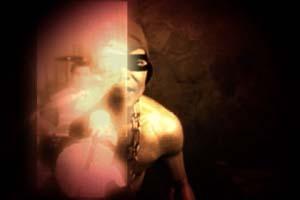
Mark O'connell
All Broke Up
Art vidéo | dv | color | 3:58 | USA | 2004
"What? Torture!?! I didn`t see any torture. Did you see some torture? Nobody saw any torture....."
Mark O`Connell probes and pushes the emerging representational, juxtapositional possibilities afforded by today`s expanding range of digital media. After a score of years in music--as a performer, composer, and producer--he now works with a variety of media: still images, video, film, music and text; all manipulated as digital information. The finished pieces are generally delivered via videotape or Quick Time computer files. His work has been exhibited in a wide range of venues.
Alison O'daniel
Catalogue : 2007Deep Woods | Experimental video | dv | color | 5:30 | United Kingdom | 2005
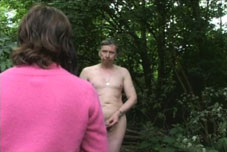
Alison O'daniel
Deep Woods
Experimental video | dv | color | 5:30 | United Kingdom | 2005
A woman's back, somewhat to the left of centre, fills the image. She is standing straight in front of the camera, which now and then registers a glimpse of the man who is standing face to face with her at a few metres' distance, somewhere in a forest. Camera, man, and woman are barely moving, while the voice-over clarifies the context of what is happening. The voice probably belongs to the man, of whom we have just seen enough to be able to decide that he must be an elderly gentleman. He explains that he is always looking for new challenges, experiences and boundaries. He is wondering how it will affect him, whatever it is he is going to do later, and about which the viewer can still only take a guess. The voice-over appears to be based on a conversation or correspondence that took place between him and the woman before the recording. He admits that he feels embarrassed and uncomfortable with the situation and with the idea that he is going to do something like that in her presence, and in that of the camera crew and eventually, of an audience. Then, as the camera moves along, we see how he calmly starts to undress. He hands his clothes to the woman. How will his body respond in these circumstances, will it cooperate gracefully, or will it embarrass him? He is not a model or an actor, he says. He looks alternately at the woman or just past her into the camera, or sideways and upwards. Very calmly he carries out the agreed action, and within a few moments it is done, upon which she hands him a cloth and his clothes.
Doireann O'malley
Catalogue : 2019Prototype I: Quantum Leaps in Trans* Semiotics through Psycho-Analytical Snail Serum | Video | 4k | color | 36:35 | Ireland, Germany | 2018
Doireann O'malley
Prototype I: Quantum Leaps in Trans* Semiotics through Psycho-Analytical Snail Serum
Video | 4k | color | 36:35 | Ireland, Germany | 2018
In Prototypes the viewer is guided sonically and visually through various dream- and land-scapes, observing psychoanalytic references to both shamanistic pasts and speculative futures that evoke alternate modes of existence. We meet the protagonists who interact with undefined technologies and it appears ambiguous as to whether they are rendering themselves in a virtual world, a potential future, or creating their present. In fact, throughout Prototypes there is little to distinguish between “the symbolic, the imaginary, and the real”. Psychoanalytic sessions emphasise a transgression of boundaries. The viewer becomes increasingly disoriented between the physical and dream worlds, where the psyche presents symbols as metaphors for psychological obstacles to overcome. Working with a cast of almost entirely non-professional actors in a collaborative process was integral to the work. Several of whom attended a dream workshop and shared their own dreams, which were then, too, woven into the script. In an exquisite corpse of unconscious connection, one protagonist’s dream depicts a tongue, abstracted and contrasted against the director’s own dream of tentacles growing from a stomach. One of the protagonists, Pol, professes that the experience of taking testosterone feels like being in a science fiction movie. Through an experiential understanding of the pliant body made available through bio-hacking, the protagonists begin to sense a form of liberation, a way to indirectly denounce systems of control. They experience an expanded potentiality to create for themselves new meanings and languages, new architectures. Pol’s analogy concretes what is alluded to throughout the film, that this depicted version of reality is one formerly unimaginable, consequently allowing us to further speculate on an abundance of potential futurities. A gay cruising scene suggests that the result of Pol’s bio-hacking allows him access into this formerly unimaginable reality.
Doireann O’Malley, born Limerick, Ireland 1981. Lives and works in Berlin, Germany. Prototypes was the winner of The Berlin Art Prize 2018 and has been exhibited in The Hugh Lane Gallery, Dublin, Edith Russ Haus für Medienkunst, Oldenburg and has been screened in Bobs Pogo Bar, KW, Berlin. Doireann is currently participating on The Berlin Program for Artists and has upcoming shows in Mexico City and the Göteborg Biennial.
Doireann O'malley
Catalogue : 2023New Maps of Hyperspace | VR 360 video | 4k | color | 6:44 | Ireland | 2020

Doireann O'malley
New Maps of Hyperspace
VR 360 video | 4k | color | 6:44 | Ireland | 2020
The work is a parable on Alan Turing’s technological disembodiment, drawing on concepts from Terrence McKenna’s Hyperspace, an undoing of the matter of consciousness and technologies empty promises of liberation and progress. Imagining a future self calls for a dreaming of the kind Terence McKenna evokes in his essay New Maps of Hyperspace (1989) and from which this work formed the research. For McKenna the dream is “zero time” and “outside of history.” It is analogous to the speculative experience of hyperspace, a scifi term given to the space-time continuum in which it is possible to travel faster than light. In both states, time appears to stand still (Einstein’s theory of relativity tells us that the closer an object travels to the speed of light the slower time becomes). Dreaming can quickly turn to nightmare however, and the episodic repetition of history-as-nightmare can, at times, feel like farcical simulation. Finally this work touches on the yawning gaps between our wish for escape, human connection and approval — and our seemingly Sisyphean task of achieving any of it. Hyperspace is a notion from science fiction of a superluminal method of travel. It is typically described as an alternative “sub-region” of space co-existing with our own universe which may be entered using an energy field or otherdevice. In most fiction, hyperspace is described as a physical place that can be entered and exited. Whereas in the VR work the viewer is essentially trapped in blue screen of death, unable to escape. (Text by Thomas Butler)
Doireann O’Malley (born 1981 in Limerick, IE) is a multidisciplinary artist based in Berlin. Their research-led practice unites collaborative methodologies, healing and reparative movement, writing, and theory, with a strong technological emphasis on new media, virtual Reality, 3Dand film installation. O’Malley holds an MFA from University of Ulster in Belfast, UK. From 2021- 2022 held the position of Professor of Gender & Space at Akademie der bildenden Künste Wien. They were a research fellow at the Berliner Förderprogramm Künstlerische Forschung (2020-2021) and a participant of the BPA// Berlin programme for artists (2019-2020). They acted as a guest mentor on the The Live Arts MA / AdBK Nuremberg (2001) Their exhibitions, talks and screenings have been presented at IMMA, Dublin, IE; Art Institute, Basel, CH; Biennale Zielona Góra, PL; Goethe-Institut Montreal, CA; Goethe-Institut, NY, USA; Neuer Berliner Kunstverein (n.b.k.), Berlin, DE; National Sculpture Factory/Cork Film Festival, Cork, IE; GöteborgInternational Biennial for Contemporary Art, SE; Rencontres Internationales, Forum des Archives, Paris, FR & HKW, Berlin, DE; Mumok Kino, Vienna, AT; Dublin City Gallery, Dublin, IE; KW Institute for Contemporary Art, Berlin, DE; Berlin Art Prize, 2018, Berlin, DE; Edith-Russ-Haus für Medienkunst, Oldenburg, DE.
Chris Oakley
Catalogue : 2007Sight/Seeing | Experimental video | dv | color | 6:0 | United Kingdom, Germany | 2005
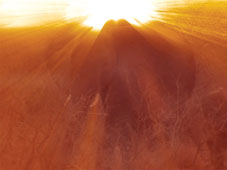
Chris Oakley
Sight/Seeing
Experimental video | dv | color | 6:0 | United Kingdom, Germany | 2005
"SIGHT/SEEING" explores our relationship with notions of wilderness in a globalized era. Part dystopic travelogue and part wildlife documentary, the piece explores our relationship with the natural environment, based on received notions handed down by the mass media. Tourism has created a process of commoditization of the natural world, typified by the modern safari, based upon experience as spectacle, consumed through the lens of the domestic camcorder. The video explores a phenomenon where spectacle undermines experience, and seeing becomes secondary to recording. Increasingly absurd photographic defects and the behind-the-lens presence of the tourist move us towards a position where the romantic tourist gaze is made concrete in the recorded image; a world seen through an experiential filter that cannot be removed.
An artist working with video and digital imaging, Chris Oakley's concerns are focused on mediated experience in its many forms, including mainstream media, amateur photography, mass communications, and augmented reality. In a critical analogy to the methods employed by mass media, he utilises processes of fictionalizing material captured from life in an attempt to define a space between actuality and representation; the point at which the white noise of lived experience is made to conform to strict linear narrative. In the past 3 years, Oakley's works have received widespread media attention within Europe and beyond. His works have been shown alongside those of Tony Oursler, Jozef Robakowski, and Pipilotti Rist. His recent achievements have included exhibition at a number of major international media arts festivals and exhibitions; these include Transmediale .05 in Berlin; exhibition of work at the Museum of Contemporary Art, Los Angeles, and via video billboards on Sunset Strip; and a prize win at the Media Forum of the Moscow International Film Festival in 2005. He is also the first video artist to sell his work via Internet downloads.
Catalogue : 2006The Catalogue | Art vidéo | dv | color | 5:42 | United Kingdom | 2004

Chris Oakley
The Catalogue
Art vidéo | dv | color | 5:42 | United Kingdom | 2004
"The Catalogue" explores the codification of humanity on behalf of corporate entities within the consumer environment. As consumers, our lifestyles have become the object of corporate scrutiny. The loyalty card, RFID (Radio Frequency Identification) chip, and facial recognition software as means of corporate data harvesting have achieved real-time tracking capabilities. Data brokers can show where we are, what we are buying, and what our wants will be. The potential already exists to extend this data beyond our purchasing habits and lifestyle choices to our very fabric, with predictions of our future health prospects made en masse via analysis of the data from our weekly shop. The Catalogue offers an analogue to this process, forcing the viewer into the position of a remote and dispassionate agency, observing humanity as a series of units, whose value is defined by their spending capacity and future needs.
Chris Oakley?s concerns span the mass media, amateur photography, mass communications, data harvesting, and the influence of these disparate phenomena upon our behaviours, interactions, and our relationship with our bodies themselves. For Oakley, the domestic camcorder, the CCTV camera and the television documentary are seen as parallel phenomena; both provide a point of view representing a mediated world, a limited reality without veracity. In a critical analogy to the processes employed by elements of the mass media, he is fascinated by a process of fictionalising material captured from life, attempting to define the space between actuality and representation, the point at which the white noise of lived experience is made to conform to strict linear narrative. Influenced at an early stage by process art and the Structuralist and Materialist filmmakers in particular, he has developed a vocabulary combining a process-oriented approach with broader cultural references. Appropriating techniques from the television newsroom and film production and combining these with a vérité viewpoint, the process is as much about framing the viewer as the subject. In the past 2 years, Oakley?s works have received widespread media attention within Europe and beyond. His works have been shown alongside those of Tony Oursler, Jozef Robakowski, Kutlug Ataman and Pipilotti Rist. His recent achievements have included exhibition at a number of major international media arts festivals and exhibitions; these include the EXIT festival in Paris, Transmediale .05 in Berlin, exhibition of work at the Museum of Contemporary Art, Los Angeles and via video billboards on Sunset Strip, and a prize win at the Media Forum of the Moscow International Film Festival in 2005. Biography 1971 Born in Chester 1988 - 1990 North East Wales Institute 1990-93 School of Art & Design, University of Wolverhampton 1993-95 Kent Institute of Art & Design
Damir Ocko
Catalogue : 2017The Third Degree | Video | hdv | color | 10:30 | Croatia | 2015
Damir Ocko
The Third Degree
Video | hdv | color | 10:30 | Croatia | 2015
The Third Degree is a single scene film exploring a close-ups of skin scars resulting from third degree burns filmed through an installation of broken mirrors reflecting the crew and the whole background process while filming the scars, thus integrating the subject of the camera with the process of filming itself. The Third Degree was made as a response to questions that emerged due the particularly violent way the previous film TK was filmed. The term "Third Degree" has an ambiguous meaning in the English language: it is a way to classify a burn of a very strong degree, but it can also signify a process of extorting a confession under violence. Set in motion by such violent interpretations and perspectives, film tries to critically, yet poetically, cut through the collective haze that blurs relations between means of production, control and the subject itself, giving rise to alternative methods of understanding as a reflection determined at the same time by social, political and aesthetic parameters.
Damir Očko was born in 1977 in Zagreb, where he lives and works. A graduate from the Academy of Fine Arts in Zagreb. Očko has exhibited on solo exhibitions at DAZIBAO, Montreal, Palais de Tokyo in Paris, Künstlerhaus Halle für Kunst und Medien in Graz and Kunsthalle Dusseldorf, Temple Bar Gallery and Studios in Dublin among other places. He participated in numerous group exhibitions internationally with institutions such as, MUDAM in Luxembourg, FRAC le Plateau, Württembergischer Kunstverein Stuttgart, Germany, Kunsthalle Vienna, among others. His works can be found in the collections of Louis Vuitton Foundation for Creation and CNAP – Centre national des arts plastiques in Paris or at the MUDAM in Luxembourg. Damir Očko was representing Croatia in the 56th Venice Biennale with a solo exhibition "Studies on Shivering / The Third Degree.
Damir Ocko
Catalogue : 2016TK | Experimental film | 4k | color | 19:46 | Croatia | 2015
Damir Ocko
TK
Experimental film | 4k | color | 19:46 | Croatia | 2015
Departing form an eight part poem the artist constructs a complex polyphonic work in which poetry meets movements, sounds, silences, bodies, and ¬endurability in order to project the ideas behind the work. Several topics constantly reoccurring through out the work are brought forward by a meticulously scored narration, in which pause and silence are equally important as the spoken or written word. Poem itself depicts on various images, starting as a morning song in which a question of a routine and a rotation turns the engine on for work to move towards more difficult imagery. People gather in dangerous constellations to act in violence, to observe silently, or to setup the false feeling of tranquillity which is constantly turned upside down by the various mechanisms of the film itself. Heavy things get stuck in the throat, stones used as tools and voices come to unrest.
Damir Očko (b. 1977, lives and works in Zagreb) is one of the most prominent Croatian artist of his generation. His videos, films, poetry and works on paper have been exhibited recently in Temple Bar Gallery in Dublin (2014), KM - Künstlerhaus Halle für Kunst & Medien in Graz (2014), Yvon Lambert gallery in Paris (2013), Palais de Tokyo in Paris (2012), Galleria Tiziana Di Caro in Salerno (2012), and Kunsthalle Dusseldorf (2011). He participated in numerous collective exhibitions with institutions such as MUDAM, Luxembourg, FRAC Le Plateau in Paris, Kunsthalle Wien, and Museum of Contemporary Art in Zagreb among others. His works are part of many public and private collections around the world.
Damir Ocko
Catalogue : 2008The Boy with a magic Horn | Art vidéo | dv | color | 16:0 | Croatia | 2007
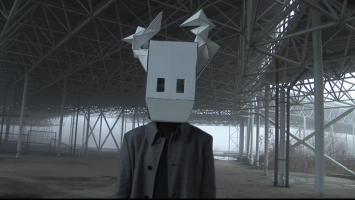
Damir Ocko
The Boy with a magic Horn
Art vidéo | dv | color | 16:0 | Croatia | 2007
?Great dream was about to be built, But something happened while we were awakening.? Through the transition period Croatia has left behind one of the biggest projects ever to be built in this hemisphere, University hospital that would occupy almost 250000m2. Hospital was planed out in the late 70`s and was being built through the 80`s, but was never finished. Now days these empty halls, concrete walls, labyrinths of unmarked rooms and nature invading the whole environment might seem like random construction but the knowledge of what this place should be is twisting this reality into an almost melodramatic experience. Being stuck in the place and time, somewhere between what it was, what it should be and what it is. Romantic vision of transition brings us inside the ghost architecture and we participate in the journey thru adopted Wagnerian plot, where fiction fits into reality, changed and lost in a place where hero comes to late. Extracted from Wagner synopsis plot becomes a dreamy and hallucinogenic game that characters play in order to describe their new social and emotional displacement, a place that exist somewhere between hope and oblivion. But than again it is told that the magic horn has such an effect that one who hears it will believe almost anything.
Damir Očko was born in 1977 in Zagreb, Croatia and studied at the Academy of Fine Arts, Zagreb. He was a resident artist at Tirana Institute of contemporary art, Tirana, Albania and Kulturkontakt Vienna, Austria. He also received a Academie schloss solitude fellowship. He is working in diverse medias, like video, installation, site specific projects and music. His recent solo exhibitions include: Why does Gravity make things fall?, Tirana Institute of Contemporary Art, Tirana, Albania, The Missing Mountain, Barutana, Osijek, Croatia, Compositions, Museum of Contemporary Art, Zagreb, Croatia. Recent group exhibitions include: The post Cinema experience, Australian centre for photography, Sydney, Australia, New revelations, Spectrum project space, Perth, Australia, Heroes in Transition, Angel Row Gallery, Nottingham, UK, and 2WP at Art Point Gallery Vienna, among others. His films where recently screened at Chavoul cinema, Sydney, Australia, 52nd Venice Biennale as part of a video program selected by Edi Muka on the PS1&PAN boat and International center for culture Arbnori, Tirana, Albania among others. Currently he is living and working in Zagreb.
Damir Ocko
Catalogue : 2025The Dawn Chorus | Video | 4k | color | 17:43 | Croatia | 2023
Damir Ocko
The Dawn Chorus
Video | 4k | color | 17:43 | Croatia | 2023
"The Dawn Chorus" is an outbreak of birdsong at the start of a new day, depicted in the film as the inspiration for a dream-like gathering of the artists local queer community in Zagreb. This joyous celebration of queer bodies pays homage to the kingdom of birds through voguing, dancing, drag and costumes. It is a transposition that imagines the potential in the intersection between our own identities and the inclusive spaces that are open for other species. Filmed without the predictable popular electronic beats typically associated with ballroom, the film solely features the sounds of bodies in motion, the rhythmic impact of dancing, resounding percussive noises created by bodies, and chanting. These elements are accompanied by polyphonic sounds of birdsong onomatopoeias, sourced from ornithological manuals and sung by ”Le Zbor” a lesbian-antifascist choir from Zagreb accompanied by subtle gravity-like pedal tones played on Organ.
Damir Ocko (b. 1977, Zagreb) Graduate from the Academy of Fine Arts in Zagreb, O?ko has exhibited on solo exhibitions at Kunsthalle Krems, Museum of Contemporary Art Zagreb, Jeu de Paume, Paris, National Gallery in Prague, Museum of contemporary Art Bordeaux, Museo Amparo, Mexico, DAZIBAO, Montreal, Palais de Tokyo in Paris, Yvon Lambert Gallery in Paris, Künstlerhaus Halle für Kunst und Medien in Graz, Kunsthalle Dusseldorf, Temple Bar Gallery and Studios in Dublin, Kunstverein Leipzig among other places. He participated in numerous group exhibitions internationally with institutions such as, OFF Biennale Budapest, MUDAM in Luxembourg, FRAC le Plateau, Württembergischer Kunstverein Stuttgart, Kunsthalle Vienna, Louis Vuitton foundation among others. Damir O?ko represented Croatia in the 56th Venice Biennale with a solo exhibition "Studies on Shivering / The Third Degree. His works are included in many public and private collections such as FRAC le Plateau, Foundation Louis Vuitton, CNAP – Centre national des arts plastiques in Paris, MUDAM in Luxembourg and Museum of contemporary Art in Zagreb, among others.
Christoph Oertli
Catalogue : 2020Sensing Bodies | Experimental doc. | 4k | color | 48:0 | Switzerland | 2019
Christoph Oertli
Sensing Bodies
Experimental doc. | 4k | color | 48:0 | Switzerland | 2019
‚Sensing Bodies‘ deals with the use of our bodies in a perfectly structured and built environment. The film takes a look at a highly organized society and explores questions of active body experience versus the static state of the virtual experience. How far from nature can humans live their lives?
1962* Winterthur/Switzerland, lives and works in Basel/Switzerland. education ZHdK Zürich, Graphic design; Swiss Television Zürich, stage design; FHNW Basel, audiovisual design. from 1995: videotapes, video installations, documentary videos, video for dance and theater. Works 1995-97 on cruise-ships around the world, lives 1998-2000 in Montréal/Canada and 2002-07 in Paris, 2008-16 in Brussels. 2000-02 lecturer for video Fachhochschule Vorarlberg/Austria. from 2004 guest lecturer HSLU Lucerne/Switzerland.
Catalogue : 2013Monsieur René | Video | hdv | color | 11:11 | Switzerland, Belgium | 2012
Christoph Oertli
Monsieur René
Video | hdv | color | 11:11 | Switzerland, Belgium | 2012
The camera is invading an over-stuffed apartment, floating through an almost surreal material world. There is a presence of the real tenant, supposedly an old man, who we don?t get to see. Instead, a younger man in search of a place to rest is wandering about. The rooms reveal the standstill of a lonley person, who has separated himself from life and the outside world by pileing up consumer objects. A glance out of the window shows a formerly fancy boulevard in Brussels, ruled today by Moroccan traders and African immigrants.
1962* Winterthur/Switzerland, lives and works in Basel/Switzerland and Brussels/Belgium HGK Zürich, Graphic design; Swiss Television Zürich, stage design; HGK Basel, audiovisual design. videotapes, video installations, documentary videos. Works 1995-97 on cruise-ships around the world, lives 1998-2000 in Montréal/Canada and 2002-07 in Paris, then moves to Brussels. 2000-02 lecturer for video Fachhochschule Vorarlberg/Austria. From 2004 guest lecturer HGK Lucerne/CH.
Catalogue : 2012The ground is moving | Video | hdv | color | 10:30 | Switzerland, Belgium | 2010
Christoph Oertli
The ground is moving
Video | hdv | color | 10:30 | Switzerland, Belgium | 2010
1962* Winterthur/Schweiz, lebt und arbeitet in Basel und Brüssel. HGK Zürich, Grafik; Schweizer Fernsehen Zürich, Bühnenbild; HGK Basel, Audiovisuelle Gestaltung. ab 1995: Videobänder, Videoinstallationen, Dokumentarfilme. Fährt 1995-97 auf Schiffen rund um die Welt, lebt 1998-00 mehrheitlich in Kanada, ab 2002 in Paris, ab 2007 in Brüssel. 2000-02 Dozent für Video an Fachhochschule Vorarlberg/Oesterreich. 2004/06/11 Gastdozent HSLU Luzern.
Catalogue : 2011Come on into the continents | Video | dv | color | 5:50 | Switzerland | 2009
Christoph Oertli
Come on into the continents
Video | dv | color | 5:50 | Switzerland | 2009
Outside of Luxor the eye moves in a slow circle. People are standing in the desert, alone or in groups. Tourists descend from the sky in a large red balloon. The camera?s perspective corresponds to the gaze of a foreigner having a look around. A couple of details sail past, without for all that rendering the situation as a whole perceptible. The eye wanders on across the surface of the desert. Urban settlements come into view. An arrival is summed up in one long, slow pan, a touchdown on a strange planet, recounted from a horizontal perspective only gradually closing the gap between itself and its object.
* Winterthur/Switzerland, lives and works in Basel/Switzerland and Brussels/Belgium education: HGK Zürich, Graphic design; Swiss Television Zürich, stage design; HGK Basel, audiovisual design. Author of videos, video installations, documentary videos.
Catalogue : 2007Cairo | Experimental video | dv | color | 11:0 | Switzerland | 2006
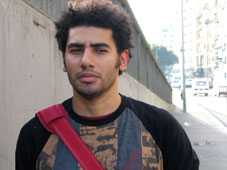
Christoph Oertli
Cairo
Experimental video | dv | color | 11:0 | Switzerland | 2006
The video focuses on the paths walked in this city. The paths that everyone has to walk, for themselves, alone among the others. In real everyday life, this constitutes a dense and permanent displacement of the masses, so they can find housing and a job. People from Cairo have to find their way around in this huge city. The video shows a young man who is walking very slowly. He takes on nine different faces and his way covers a whole area of Cairo districts. All around him is noise and many other people. Then he suddenly finds himself alone, but continues to walk slowly, not giving attention to this fact. He comes across several solitary people with along his path.
Christoph Oertli was born in 1962*. He lives in Basel and Paris. His studies include graphic design Swiss television at HGK Zurich, and stage and audiovisual design at HGK Basel.
Catalogue : 2006Come, heavy sleep | Experimental video | dv | color | 8:0 | Switzerland, France | 2004

Christoph Oertli
Come, heavy sleep
Experimental video | dv | color | 8:0 | Switzerland, France | 2004
A living room at night, selectivley furnished. No trace of inhabitants. A naked young man repeatedly crosses the space. He lies down on a sofa. He puts a dish on the table. He acts like a stranger who has crept into the house. Furniture trembles, appears, disappears as if moved by an invisible hand. The intimacy and nearness to the man?s body contrasts sharply with the view seen from outside; we are actually looking through a shop window.
*Winterthur/Switzerland, lives in Basel and Paris Studies: HGK Zurich, Graphic design Swiss Television, Stage design HGK Basel, Audiovisual arts
Dietmar Offenhuber, Sam AUINGER
Catalogue : 2006Heinz weiss (naredmanet) | Experimental video | dv | color | 4:0 | Austria | 2005
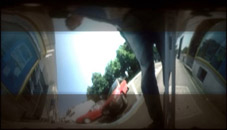
Dietmar Offenhuber, Sam AUINGER
Heinz weiss (naredmanet)
Experimental video | dv | color | 4:0 | Austria | 2005
Some time ago, a moving company cleared out the residence of the retired Heinz k. (name changed). Among his belongings were a tape recorder including a 90-minute tape. Heinz K. spent the last 5 years of his retirement spying on his neighbors and recording his thoughts and observations. The Munich based record label ?bodensatz? came into possession of the tapes, which they kindly made available to us as raw material for our film.
Dietmar Offenhuber, born 1973, graduated in Architecture and has been working since 1994 in animation, interactive environments and digital architecture. Between 2002 and 2004 Dietmar worked as key researcher in the Interactive Space departement at the Ars Electronica Futurelab. Since Fall 2004 he is Professor for animation and interactive media at the University of Applied Sciences in Hagenberg / Austria.
Anna Ogden Smith
Catalogue : 2012The Lie | Video | | color | 2:40 | Lebanon | 2008

Anna Ogden Smith
The Lie
Video | | color | 2:40 | Lebanon | 2008
Catalogue : 2012The Dream | Video | | color | 2:10 | Lebanon | 2008

Anna Ogden Smith
The Dream
Video | | color | 2:10 | Lebanon | 2008
Anna Ogden-smith
Catalogue : 2009The Dream (VHS: 1989-1994) | 0 | dv | color | 4:20 | Lebanon | 2008
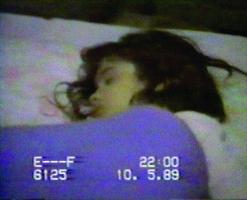
Anna Ogden-smith
The Dream (VHS: 1989-1994)
0 | dv | color | 4:20 | Lebanon | 2008
While stumbling across a collection of home made videos my mother recorded from 1989 up until 1994, I became very interested in how VHS archives serve the process of filtration of our memory. Can I alter this registered memory by re appropriating these records and infiltrating them? How do the recorded and the remembered intersect and collide?
Born in Beirut, Lebanon, in 1984, Anna Ogden-Smith graduated with a BA in Graphic Design from the American University of Beirut in June 2006. Since then, she has mainly worked as a freelancer in print design and has pursued her vocation as a contemporary dancer in London and Beirut. More recently, she started exploring different mediums of which these two auto fictions, "The Lie" and "The Dream", are a result.
Senem Gökce Ogultekin, Levent Duran
Catalogue : 2025Void | Experimental film | digital | color | 16:57 | Turkey, Germany | 2024
Senem Gökce Ogultekin, Levent Duran
Void
Experimental film | digital | color | 16:57 | Turkey, Germany | 2024
While the shade of a tree is being stolen away, bodiless organs sit in the enormous gaps of the drained earth. Under the constant noise of unseen machines, disjointed body parts touch the drying soil and breaths are only audible to insects. In this quiet, distorted world, old songs of goodwill are sung: “Future times of vain sorrow do not disturb our gentle sleep...” While we are waiting for the miracle to come the sand continues to fly.
SENEM GÖKCE OGULTEKIN work spans the disciplines of choreography, performance, vocal work and film. In 2019, "Dun/Home" was chosen for Artist´s Film International, an international event initiated by Whitechapel Gallery in London and was shown at various museums and galleries of the world. In 2020, Senem Gökce Ogultekin was awarded the Allbau Foundation Culture Prize and was appointed to the Young College by the North Rhine-Westphalian Academy of Sciences and Arts in 2021. LEVENT DURAN is a multidisciplinary artist and writer. They studied sociology at Istanbul University and film at the Fine Arts University of Hamburg, where they obtained their master's degree. Their writings have been published in major magazines and newspapers in Turkey, and their visual creations (video, painting, sculpture, installation) have been exhibited internationally. Their film project "Murmuring Draft Dodgers" received the Courageous Citizen Award from the European Cultural Foundation.
Yuki Okumura
Catalogue : 2008Countdown in NYC | Art vidéo | dv | color | 1:43 | Japan | 2006
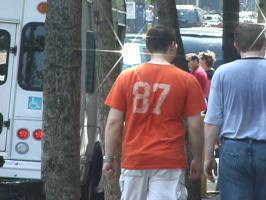
Yuki Okumura
Countdown in NYC
Art vidéo | dv | color | 1:43 | Japan | 2006
The artist videotaped people on the road in New York City who wear T-shirts with numbers, and reassembled them to count down from 99 to 0. It is about revealing or reconstructing an order hidden in the chaos of the city.
Bon in Aomori, Japan, 1978, Yuki Okumura is a video installation artist based in Tokyo, having exhibited his work both domestically and internationally. He was awarded grand prix of Philip Morris Art Award 2000 and is the recipient of the 2006 Asian Cultural Council fellowship to be an artist in residence at Location One, New York. The other residency programs he has participated include Taipei Artist Village, Taipei and Irish Museum of Modern Art, Dublin in 2007.
Erwin Olaf
Catalogue : 2011dusk & dawn | Video | 35mm | color and b&w | 5:12 | Netherlands | 2009
Erwin Olaf
dusk & dawn
Video | 35mm | color and b&w | 5:12 | Netherlands | 2009
Dusk: A mother mourns the death of her husband while her son questions his existence. Dawn: A mother mourns the death of het child, while her husband tries to deal with the death and the misshapen newborn.
Erwin Olaf Born in Hilversum in the Netherlands in 1959, Erwin Olaf lives and works in Amsterdam since the early 80`s. His current studio is situated in a former church hall. Mixing photojournalism with studio photography, Olaf emerged in the international art scene in 1988 when his series `Chessmen` was awarded the first prize in the Young European Photographer competition. This award was followed by an exhibition at the Ludwig Museum in Cologne, Germany. Since then Olaf has continued to explore issues of gender, sensuality, humor, despair and grace in each successive series. Printing his early work in documentary style black-and-white, he first gradually introduced color and then digital manipulation. There is great contrast between each series. Mature (1999): golden-hued portraits of elderly women in the poses of kittenish supermodels; Fashion Victims (2000): a lewd commentary on the consumerism of sex and designer labels; Royal Blood (2000): minimalist white-on-white portraits, depicting the vengeful nature of members of the aristocracy who have suffered unsavory deaths; Paradise (2001): picturing a dark and baroque underworld of gleeful clowning and lunacy; Separation (2003) portraying an ice cold and introverted family in a sterile living room. In his four most recent series Rain, Hope, Grief and Fall, Erwin Olaf returns to classic imagery with minimal computer retouching. Video and film offer new possibilities to explore. His first film Tadzio (1991, co-directed with painter F. Franciscus) was soon followed by comic videos for children`s television, short documentaries, music clips and commissions by the Dutch National Ballet. Recently Olaf has created autonomous video works like Separation, Rain and Grief, starring models who also appear in the accompanying photo series. In the films they play a different character, as though his moving images provide a parallel history to his color photographs. These short films have been selected for film festivals all over the world. Over the years many of Olaf`s works - from his unabashed nude portraiture and intense symbolism to the unflinching gaze in his blood-drenched images of staged violence - have provoked controversy. Not surprisingly, this ability to attract attention has seen his work embraced by the advertising world, resulting in commercials for Lavazza, BMW, Microsoft and Nintendo among many others. Lately Erwin is frequently shooting in commission for magazines such as The New York Times Magazine, The Sunday Times Magazine, Elle and Citizen K. In 1999 his worldwide campaign for Diesel Jeans won him the coveted Silver Lion at the Festival for Advertising in Cannes. He was awarded the same prize two years later for his imagery produced for Heineken. Among numerous other international art and media prizes, in 2006 he was awarded Photographer of the Year in the International Color Awards. In 2007 Kunstbeeld magazine chose him Artist of the Year of the Netherlands. Recently he received a Lucie Award for his entire oeuvre
Erwin Olaf
Catalogue : 2012La tristesse riche | Experimental fiction | hdcam | color | 10:30 | Netherlands | 2010
Erwin Olaf
La tristesse riche
Experimental fiction | hdcam | color | 10:30 | Netherlands | 2010
Erwin Olaf
Catalogue : 2008Grief | Experimental video | dv | color | 3:59 | Netherlands | 2007

Erwin Olaf
Grief
Experimental video | dv | color | 3:59 | Netherlands | 2007
Grief NL, 2007, 3`59? Thunder-like sounds accompany the image of a woman who, withdrawn into herself, is staring out of the window. A radio voice, only partly intelligible, reports on certain events, and a second woman hesitantly enters the room. Neither woman says anything; silence persists between them. The rain, the radio, the back of the woman at the window and the tenseness of the visitor keep one another in a grip. Interacting with the radio report the claps of thunder suddenly sound threatening, and the viewer begins to suspect that there is a connection between the thunderstorm, the vague messages seeping through into the room and the state of mind of the waiting woman who remains physically unapproachable to the other. She keeps on turning her back on her; she is hiding her silent tears. In one single scene and with minimal means, Grief conjures up a whole story of unfolding misery.
Erwin Olaf was born in 1959 in Hilversum, The Netherlands. Olaf has a passionate love affair with life, and enjoys to the full everything it has to offer. His oeuvre is a manifestation of his passion and of his genuine engagement with his subjects. Olaf has been professionally active for twenty-five years and in this period he has succeeded in evolving from a participating photographer to a director who creates his own reality. Olaf's pictures are filled with humor, imagination and exuberance, but they go much further than simple visual intrigue. His works deal with freedom, beauty, loneliness, and being different. He convinces his public in a shameless and versatile manner, questioning established norms. Olaf consistently expresses his own standpoints, fulminating against narrow-mindedness, smugness, and rigid norms, but not without humor, bravura and bite. An authentic Olaf is a blow to the head, ruthlessly direct, but simultaneously wrong footing the viewer and poking fun. One reviewer remarked that in Erwin Olaf's photographs everyone stares unwaveringly into the lens--thus looking straight into the photographer's big blue eyes, as it were. Olaf approaches the world openly and enthusiastically and this is also the way in which, in his work, he dares to enter the public debate. Olaf is a master in generating his own world, whether this be in autonomous photographic series or film projects. He is also hypercritical, nothing escapes him, so that pictures are created with a placement composed so meticulously that it is almost painful to examine. With these, Olaf manages to produce fictitious yet convincing images of bygone days, fairytales and dreams, populated by historical figures, elves, dwarves, lunatics, and god knows who.
Jaamil Olawale Kosoko, Ima Iduozee
Catalogue : 2022Chameleon (A Visual Album) | Video | hdv | color | 21:16 | USA, Germany | 2020
Jaamil Olawale Kosoko, Ima Iduozee
Chameleon (A Visual Album)
Video | hdv | color | 21:16 | USA, Germany | 2020
Chameleon is an experimental visual album inspired by the radical queer feminist genre of the “Biomythography” which refers to Audre Lorde’s foundational work entitled Zami: A New Spelling of My Name published in 1982. It combines history, biography, and myth, and holds a literary perspective that serves as a guiding light for complex narrative storytelling rooted in a queer, Black self-defined, feminist imagination.
jaamil olawale kosoko, (they/them) of Yoruba and Natchez descent is an award winning filmmaker, movement artist, poet, and facilitator whose work in embodied poetics and performance has been presented internationally and is rooted in the intergenerational passage of Black feminist knowledge, queer theories of the body, and sacred rituals of intimacy & wellness as a means to craft perpetual modes of freedom, healing, and care where/when/however possible. Their new book, Black Body Amnesia: Poems & Other Speech Acts was released in Feb. 2022. jaamil is the recipient of a MacDowell Fellowship, PEW Fellowship in the Arts, Princeton Arts Fellowship, 2019 Red Bull Writing Fellowship, and a 2017 Cave Canem Poetry Fellowship. Their works in poetry, curation, performance and education have taken them all around the world having performed and taught in over 21 countries on 5 continents including Morocco, South Africa, Germany, Finland, Sweden, UK, Norway, Switzerland, Canada, Mexico, Japan, and throughout the Americas. Of Nigerian and Finnish descent, Ima Iduozee is a choreographer, director, dancer and filmmaker based in Helsinki, Finland. His debut solo work, This is the Title, premiered in 2012 and went on to garner international acclaim, touring in 15 countries across Europe, North America and Asia. In 2015 the annual honorary prize of the Finnish Critics Association, Critics Spurs´, was given to Iduozee, as an acknowledgement for the best artistic breakthrough of the year. Earlier commissions include works for The Finnish National Theatre, Aalto International, Stockholm City Theatre, Helsinki City Theatre, Finnish National Opera and Helsinki International Film Festival. In 2016 Iduozee graduated from the Arts University of Helsinki (Theatre Academy).
Joachim Olender
Catalogue : 2013Tarnac. Le chaos et la grâce | Animation | hdv | color | 23:0 | France | 2012
Joachim Olender
Tarnac. Le chaos et la grâce
Animation | hdv | color | 23:0 | France | 2012
Le 11 novembre 2008, cent cinquante policiers envahissent le petit village de Tarnac en Corrèze. Neuf personnes sont soupçonnées d?avoir posé des crochets métalliques sur des caténaires pour désorganiser les lignes SNCF. A l?issue de leur garde à vue, cinq d?entre elles sont placées en détention provisoire pour terrorisme. Le principal suspect restera incarcéré durant six mois sans preuve à l?appui. Voici l?affaire de Tarnac. Ce film en retrace la fiction.
Joachim Olender est scénariste, réalisateur et vidéaste. Sa démarche découle d?un va-et-vient entre l?écriture et l?image, le cinéma et la vidéo. Il a étudié le droit et le cinéma à Bruxelles. En 2006, il débute une thèse à l?EHESS sur la faille dans le cinéma US des années 2000. Accompagné par le cinéaste Luc Dardenne, il écrit un scénario de long métrage, adapté du roman Les Choses de Georges Perec, dont une première apparition se déroule à la BNF dans l?exposition « Choses lues choses vues » conçue par Alain Fleischer (fin 2009). Il est publié dans Pylône Magazine. En 2010, il intègre Le Fresnoy studio national des arts contemporains et réalise Bloody eyes (fiction 22 min, prod. Le Fresnoy, 2011), tiré d?une nouvelle de Luc Dardenne. En 2012, il réalise Tarnac. Le chaos et la grâce, documentaire d?animation entièrement tourné dans un jeu vidéo, qui explore les méandres de cette fiction d?Etat. En 2012, il entame le développement d?un documentaire sur Herman Daled et sa collection d?art conceptuel rachetée par le MOMA et s?associe à Camille de Toledo et Grégoire Hetzel dans l?opéra vidéo « La chute de Fukuyama ». Il poursuit actuellement sa recherche avec Le Fresnoy. Joachim Olender est né en Belgique en 1980. Il vit et travaille entre Paris et Bruxelles.
Mike Olenick
Catalogue : 2007For a Blonde... | Experimental video | dv | color | 5:57 | USA | 2005

Mike Olenick
For a Blonde...
Experimental video | dv | color | 5:57 | USA | 2005
"For a Blonde... For a Brunette... For Someone... For Her... For You..." is a karaoke style video that re-enacts a key scene from Alfred Hitchcock's film "Vertigo". The artist plays the role of John Ferguson at the moment when he re-discovers his Madeleine. 'Karaoke' subtitles allow the viewer to perform Kim Novak's part and complete the scene with the artist.
Mike Olenick (b. 1978) is a video artist, photographer, and editor. His work often fuses fake moments from his own life with real ones from cinema and pop culture. The resulting videos and photographs are a mangled collection of fact and fiction, comedy and tragedy, love and death. His work has been shown in the Ann Arbor Film Festival, The Oberhausen Film Festival, VIPER Basel, Cinematexas, The Brooklyn Underground Film Festival, and the World Wide Video Festival. Currently, Mike is a video editor in the Art & Technology Studio at the Wexner Center for the Arts, where he has worked on projects with Jennifer Reeder, Sadie Benning, Deborah Stratman, Andrea Fraser, Joe Sola, and Josiah McElheny, among others. He also teaches video production at the Columbus College of Art and Design. He received his MFA (with an emphasis in Photography) from the Cranbrook Academy of Art and his BFA in Media Studies from the Columbus College of Art and Design.